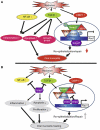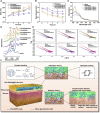Revisited and innovative perspectives of oral ulcer: from biological specificity to local treatment
- PMID: 38456005
- PMCID: PMC10917957
- DOI: 10.3389/fbioe.2024.1335377
Revisited and innovative perspectives of oral ulcer: from biological specificity to local treatment
Abstract
Mouth ulcers, a highly prevalent ailment affecting the oral mucosa, leading to pain and discomfort, significantly impacting the patient's daily life. The development of innovative approaches for oral ulcer treatment is of great importance. Moreover, a deeper and more comprehensive understanding of mouth ulcers will facilitate the development of innovative therapeutic strategies. The oral environment possesses distinct traits as it serves as the gateway to the digestive and respiratory systems. The permeability of various epithelial layers can influence drug absorption. Moreover, oral mucosal injuries exhibit distinct healing patterns compared to cutaneous lesions, influenced by various inherent and extrinsic factors. Furthermore, the moist and dynamic oral environment, influenced by saliva and daily physiological functions like chewing and speaking, presents additional challenges in local therapy. Also, suitable mucosal adhesion materials are crucial to alleviate pain and promote healing process. To this end, the review comprehensively examines the anatomical and structural aspects of the oral cavity, elucidates the healing mechanisms of oral ulcers, explores the factors contributing to scar-free healing in the oral mucosa, and investigates the application of mucosal adhesive materials as drug delivery systems. This endeavor seeks to offer novel insights and perspectives for the treatment of oral ulcers.
Keywords: bioadhesive polymers; local treatment; mucosa-inspired scarless healing; oral ulcer; ulcer-related factors.
Copyright © 2024 Pan, Zhang, Xie, Cui, Wang, Zhang, Du, Zhai, Sun, Li and Li.
Conflict of interest statement
The authors declare that the research was conducted in the absence of any commercial or financial relationships that could be construed as a potential conflict of interest.
Figures








Similar articles
-
Antibacterial, anti-inflammatory and wet-adhesive poly(ionic liquid)-based oral patch for the treatment of oral ulcers with bacterial infection.Acta Biomater. 2023 Aug;166:254-265. doi: 10.1016/j.actbio.2023.05.017. Epub 2023 May 13. Acta Biomater. 2023. PMID: 37187300
-
Biomimetic hydrogel for rapid and scar-free healing of skin wounds inspired by the healing process of oral mucosa.Acta Biomater. 2019 Dec;100:255-269. doi: 10.1016/j.actbio.2019.10.011. Epub 2019 Oct 10. Acta Biomater. 2019. PMID: 31606531
-
Janus mucosal dressing with a tough and adhesive hydrogel based on synergistic effects of gelatin, polydopamine, and nano-clay.Acta Biomater. 2022 Sep 1;149:126-138. doi: 10.1016/j.actbio.2022.07.016. Epub 2022 Jul 12. Acta Biomater. 2022. PMID: 35840105
-
Oral local drug delivery and new perspectives in oral drug formulation.Oral Surg Oral Med Oral Pathol Oral Radiol. 2012 Sep;114(3):e25-34. doi: 10.1016/j.oooo.2012.02.016. Epub 2012 Jul 6. Oral Surg Oral Med Oral Pathol Oral Radiol. 2012. PMID: 22771408 Review.
-
Cellular and molecular mechanisms of gastric ulcer healing. Is the quality of mucosal scar affected by treatment?Scand J Gastroenterol Suppl. 1995;210:9-14. doi: 10.3109/00365529509090261. Scand J Gastroenterol Suppl. 1995. PMID: 8578218 Review.
Cited by
-
Innovative nanoparticle strategies for treating oral cancers.Med Oncol. 2025 Apr 26;42(6):182. doi: 10.1007/s12032-025-02728-y. Med Oncol. 2025. PMID: 40285805 Review.
-
In vivo adhesion fault-tolerant coenzyme/queen bee acid nanomicelles self-crosslinked thermoresponsive adhesive hydrogel for efficient oral ulcer treatment.Bioact Mater. 2025 Jun 16;52:460-473. doi: 10.1016/j.bioactmat.2025.06.023. eCollection 2025 Oct. Bioact Mater. 2025. PMID: 40599345 Free PMC article.
-
A cell-free SHED lysate-hydrogel system for oral ulcer healing with anti-inflammatory and pro-angiogenic effects.J Nanobiotechnology. 2025 Jul 28;23(1):547. doi: 10.1186/s12951-025-03597-3. J Nanobiotechnology. 2025. PMID: 40722154 Free PMC article.
-
Dynamic characterization of vascular response and treatment in oral traumatic ulcer in mice via photoacoustic imaging.Quant Imaging Med Surg. 2024 Jul 1;14(7):4333-4347. doi: 10.21037/qims-24-123. Epub 2024 Jun 4. Quant Imaging Med Surg. 2024. PMID: 39022262 Free PMC article.
-
In vitro and ex vivo models of the oral mucosa as platforms for the validation of novel drug delivery systems.J Tissue Eng. 2025 Feb 11;16:20417314241313458. doi: 10.1177/20417314241313458. eCollection 2025 Jan-Dec. J Tissue Eng. 2025. PMID: 39944725 Free PMC article. Review.
References
Publication types
LinkOut - more resources
Full Text Sources

